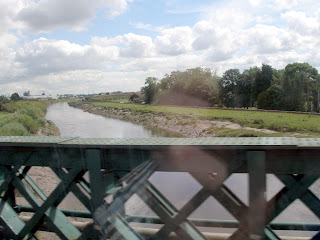The Idle's outfall is into the tidal Trent, at West Stockwith in Nottinghamshire, just a few yards downstream of the Chesterfield Canal.

But a boat entering the Idle from the Trent is a rare event, seen only on special occasions organised by local boaters.
The reason is a barrier across the Idle, just upstream of its outfall, which keeps the high-tide waters of the Trent out of the smaller river. By special arrangement, and at a suitable state of the tide, the barrier can be lifted to allow boats to pass beneath.

Then, only a little further upstream, there is a pumping-station where, when necessary, drainage water from the Idle's extensive catchment area can be raised up if the Trent's waters remain high.
The chimneys of Misterton Soss mark the site of an earlier method of water control in this low-lying area.
There is no evidence now of the crucial role the Idle played for centuries, until the 1780s. Bawtry was the furthest upstream where reasonable depths of water could carry sizable craft, so it became the port for the north midlands, a link to the national and international shipping on the River Trent. The towns and mines of the north midlands had no other outlet for water-borne transport, easily the most effective method of moving heavy cargoes before good roads and railways - by the middle of the 18th century an average-sized boat trading on the Idle was 48ft long, with a 15ft beam, carrying 12 to 24 tons. They had a mast and a square sail, and easily navigated upon the Trent.
So important was Bawtry that the initial proposals for building the Chesterfield Canal assumed its best route would be to the busy port on the Idle. In the 1770s the change in the canal's route to incorporate Retford, and therefore bypass Bawtry, proved to be the historic port's death knell. The Chesterfield Canal was a far more efficient transport route to the Trent, and it served Bawtry's catchment area. The tidal and winding River Idle could not compete.
However, local trade did continue. In 1826 the landlord of the Haxey Gate pub (pictured left) was running a market-boat, an example of many instances of licensees running such craft from somewhat inaccessible locations.

Currently Haxey Gate, just downstream of the pub, has again a trading profile with the only commercial moorings on the River Idle. (The owner has an agreement with the Environment Agency re the passage of his moorers' boats through the Stockwith barriers, but I'm not aware of the details).
Subsequent drainage realignments of the river have straightened its course to Bawtry. Apart from a sign on the road, which crosses the Idle here, there is no indication of the busy port described in 1758 - commodious wharves, coal yards, warehouses, boat-builders, timber stacks, piles of iron and lead, flax and hemp.
Instead a long viaduct, carrying the east-coast mainline railway, divides the town from the river. It's a scene which varies depending on the month of visit because this is one of the Idle's main flood-plains, part of the management system for these waters. In the summer its obvious where the river is, within a vast area of flat lands.
But in other seasons all can be covered - as here in November 2012.
On the 2nd of May 1999 the boats on the organised visit to the Idle managed to pass under Bawtry's road bridge, stopping at the last point where turning could be guaranteed, at the confluence with the River Ryton.
Although two determined crews went further along a now-winding Idle towards Mattersey. The cruise of 2009 couldn't get under the road bridge at Bawtry.
The largest town on the River Idle is now Retford, and in the past boats could struggle that far upstream, but it was never easy and many schemes for improving navigation came to nothing. So, when plans for the Chesterfield Canal were heard, in the late 1760s, the town quickly advocated a route to bypass the River Idle. Other than local trade, business on the river died out very quickly and Bawtry relied on its location on the Great North Road and the trade it bought.
When the Chesterfield Canal was conceived it was never planned that its narrowboats would venture out onto the wide waters of the tidal Trent, but they very quickly did so. My theory is that they were manned by boatmen who had once traded on the Idle and had a good knowledge of the major river. Masts were rigged on the narrowboats and square sails hoisted, just as they had on their own boats, and out they went onto the Trent - upstream to Gainsborough for the coastal trade, and Torksey for access to the Fossdyke - downstream and sometimes up the River Idle.














.jpg)

.jpg)
.jpg)
.jpg)
.jpg)

.jpg)







.JPG)
.JPG)
.JPG)
.JPG)
.JPG)
.JPG)
.jpg)
.JPG)
.JPG)
.JPG)





.JPG)
